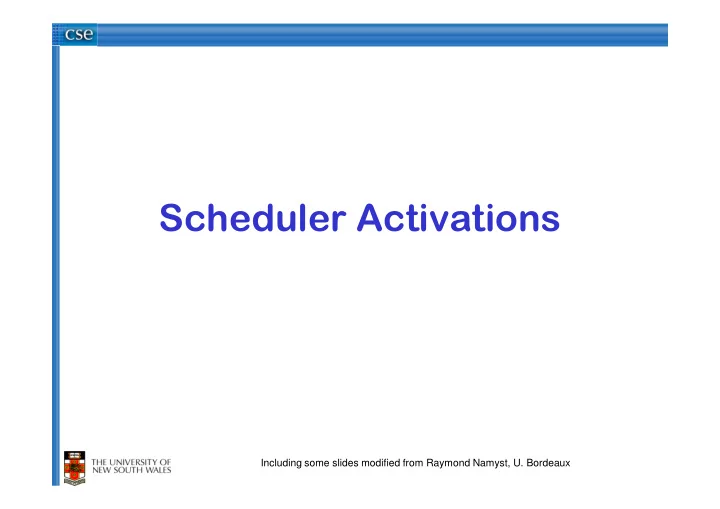

��������������������� Including some slides modified from Raymond Namyst, U. Bordeaux
����������������� • An understanding of hybrid approaches to thread implementation • A high-level understanding of scheduler activations, and how they overcome the limitations of user-level and kernel-level threads.
• Thomas Anderson, Brian Bershad, Edward Lazowska, and Henry Levy. Scheduler Activations: Effective Kernel Support for the User-Level management of Parallelism. ACM Trans. on Computer Systems 10(1), February 1992, pp. 53-79.
������������������ User Mode Scheduler Scheduler Scheduler Process A Process B Process C Scheduler Kernel Mode
������������������ � Fast thread management (creation, deletion, switching, synchronisation…) � Blocking blocks all threads in a process – Syscalls – Page faults � No thread-level parallelism on multiprocessor
�������������������� User Mode Process A Process B Process C Scheduler Kernel Mode
�������������������� � Slow thread management (creation, deletion, switching, synchronisation…) • System calls � Blocking blocks only the appropriate thread in a process � Thread-level parallelism on multiprocessor
����������� User-level Kernel-level threads threads
��������������������� User Mode Scheduler Scheduler Scheduler Process A Process B Process C Scheduler Kernel Mode
��������������������� � Can get real thread parallelism on multiprocessor � Blocking still a problem!!!
��������������������� • First proposed by [Anderson et al. 91] • Idea: Both schedulers co-operate • User scheduler uses system calls • Kernel scheduler uses upcalls! • Two important concepts – Upcalls • Notify the user-level of kernel scheduling events – Activations • A new structure to support upcalls and execution – approximately a kernel thread • As many running activations as (allocated) processors • Kernel controls activation creation and destruction
��������������������� CPU time wasted • Instead of syscall User Space I/O request interrupt Kernel Space Hardware • …rather use the following scheme: CPU used User Space upcall upcall Kernel Space Hardware
� �������������������� ��������� • New (processor #) – Allocated a new virtual CPU – Can schedule a user-level thread • Preempted (activation # and its machine state) – Deallocated a virtual CPU – Can schedule one less thread • Blocked (activation #) – Notifies thread has blocked – Can schedule another user-level thread • Unblocked (activation # and its machine state) – Notifies a thread has become runnable – Must decided to continue current or unblocked thread
!��"���� ����� �� • Blocking syscall scenario on 2 processors Process 1 2 3 4 User scheduler
!��"���� ����� �� • Blocking syscall scenario on 2 processors Process 1 2 3 4 new A A
!��"���� ����� �� • Blocking syscall scenario on 2 processors Process 1 2 3 4 new B A B
!��"���� ����� �� • Blocking syscall scenario on 2 processors Process 1 2 3 4 A B
!��"���� ����� �� • Blocking syscall scenario on 2 processors Process 1 2 3 4 Preempt A+B A B Preempt
!��"���� ����� �� • Blocking syscall scenario on 2 processors Process 1 2 3 4 B
!��"���� ����� �� • Blocking syscall scenario on 2 processors Process 1 2 3 4 A B Blocking syscall
!��"���� ����� �� • Blocking syscall scenario on 2 processors Process 1 2 3 4 New C + blocked B A B C
!��"���� ����� �� • Blocking syscall scenario on 2 processors Process 1 2 3 4 A B C I/O completion
!��"���� ����� �� • Blocking syscall scenario on 2 processors Process 1 2 3 4 Unblocked B + preempt C A B C
!��"���� ����� �� • Blocking syscall scenario on 2 processors Process 1 2 3 4 A B C
��������������������� • Thread management at user-level – Fast • Real thread parallelism via activations – Number of activations (virtual CPUs) can equal CPUs • Blocking (syscall or page fault) creates new activation – User-level scheduler can pick new runnable thread. • Fewer stacks in kernel – Blocked activations + number of virtual CPUs
�����������
����������� #��� ���������$
������������ #%&��'����$
��� ���� • Adopters – BSD “Kernel Scheduled Entities” • Reverted back to kernel threads – Variants in Research OSs: K42, Barrelfish – Digital UNIX – Solaris – Mach – Windows 7 64-bit User Mode Scheduling • Linux -> kernel threads
Recommend
More recommend